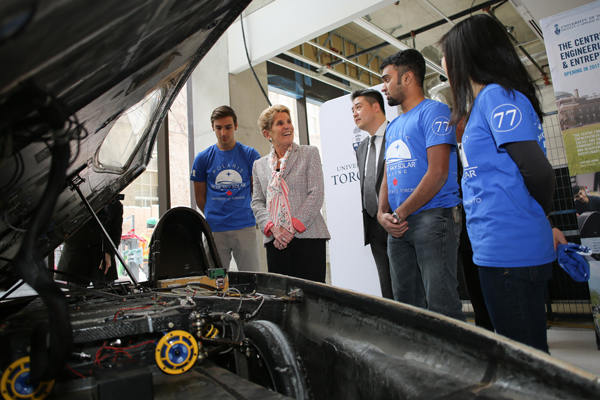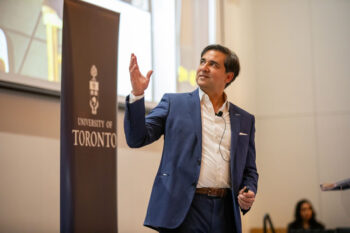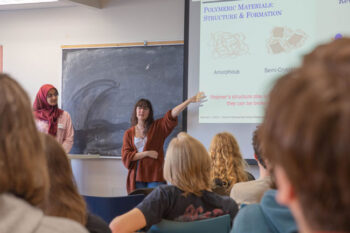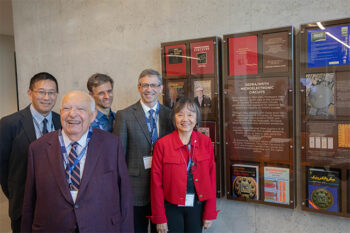On Tuesday, February 13, Ontario Premier Kathleen Wynne visited U of T Engineering to speak with students about challenges and opportunities facing students today and the importance of diversity in the STEM disciplines.
The Premier began her visit at the site of the Centre for Engineering Innovation & Entrepreneurship, the Faculty’s newest building, which will officially open in April. She met with Professor Angela Schoellig (UTIAS), who spoke about her leading research to develop algorithms for autonomous flying robots, and with Professor Jennifer Drake (CivE) who presented her pioneering work on water-permeable concrete for urban environments. She also took a tour of Polaris, the Blue Sky Solar Racing team’s latest vehicle, and a number of projects — including sounding rockets and a microsatellite — from the University of Toronto Aerospace Team.
The demonstrations were followed by a town hall-style meeting in the Lassonde Mining Building, with an audience of more than 50 U of T Engineering students.
“When we think about the challenges we face today, whether it’s climate change, big data or health, we can’t help but think about science and engineering,” said University Professor Molly Shoichet (ChemE, IBBME) who moderated the discussion. “It’s exciting to have these conversations about how we can harness our collective brain power, and bring the diversity of our cultures and genders into the conversation to solve these problems.”
Over the next hour, Premier Wynne heard from students about a wide variety of topics, from hydro pricing to artificial intelligence, and from mental health on campus to diversity in STEM.
Watch the Premier’s conversation with U of T Engineering students on Periscope
One theme that emerged was the need to overcome barriers for groups that have been traditionally underrepresented in STEM, including women, Black and Indigenous students. Wynne spoke of the current “non-systematic approach” to enriching diversity: while many universities and organizations have outreach programs designed to help people in these groups to see themselves in STEM, they don’t exist everywhere and are often are not coordinated with the provincial education system.
“I think it starts long before high school, when little kids get messages about what it’s OK for them to do and not to do,” said Premier Wynne. “When certain groups feel that certain avenues are cut off to them, that skews the participation rate.”
Wynne and the students agreed that some of the barriers to diversity in STEM are embedded in the wider culture, and that ongoing work will be required at many levels — parenting, the education system, employment standards — to change them. Still, there are steps that governments and institutions can take to lead by example, including more equitable representation on their boards of directors and examining systematic biases within their hiring practices.
“My intention as a politician is to work to level the playing field so that everyone can be at their best,” said Wynne. “That’s how the province is going to thrive.”



